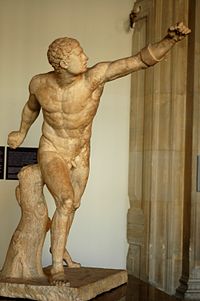| Revision as of 19:29, 21 November 2011 editFrance3470 (talk | contribs)Autopatrolled21,074 edits changing hatnote to pipe through (disambiguation)← Previous edit | Revision as of 16:35, 21 April 2012 edit undoDavidiad (talk | contribs)Extended confirmed users, Pending changes reviewers18,221 editsm clean up, replaced: {{polytonic| → {{lang|grc| using AWBNext edit → | ||
| Line 1: | Line 1: | ||
| ]''.]] | ]''.]] | ||
| {{Other people2|Agasias (disambiguation)}} | {{Other people2|Agasias (disambiguation)}} | ||
| '''Agasias''' (]: {{ |
'''Agasias''' (]: {{lang|grc|Ἀγασίας}}), son of Dositheus, was an ] sculptor of ]. One of the productions of his chisel, the statue known by the name of the ], is still preserved in the gallery of the ]. This statue was discovered among the ruins of a palace of the Roman emperors on the site of the ancient ]. From the ] of the figure it is clear that the statue represents not a gladiator, but a warrior contending with a mounted combatant. ] conjectured that it was intended to represent ] fighting with ].<ref>], ''Epochen d. bild. Kunst'' p. 130</ref> | ||
| The only record existing about the artist is the inscription on the pedestal of the statue; nor are there any data for ascertaining the age in which he lived, except the style of art displayed in the work itself, which competent judges think cannot have been produced earlier than the 4th century BC. | The only record existing about the artist is the inscription on the pedestal of the statue; nor are there any data for ascertaining the age in which he lived, except the style of art displayed in the work itself, which competent judges think cannot have been produced earlier than the 4th century BC. | ||
Revision as of 16:35, 21 April 2012

Agasias (Ancient Greek: Ἀγασίας), son of Dositheus, was an ancient Greek sculptor of Ephesus. One of the productions of his chisel, the statue known by the name of the Borghese Gladiator, is still preserved in the gallery of the Louvre. This statue was discovered among the ruins of a palace of the Roman emperors on the site of the ancient Antium. From the attitude of the figure it is clear that the statue represents not a gladiator, but a warrior contending with a mounted combatant. Friedrich Thiersch conjectured that it was intended to represent Achilles fighting with Penthesilea.
The only record existing about the artist is the inscription on the pedestal of the statue; nor are there any data for ascertaining the age in which he lived, except the style of art displayed in the work itself, which competent judges think cannot have been produced earlier than the 4th century BC.
It is not quite clear whether the Agasias who is mentioned as the father of Heraclides was the same as the author of the Borghese statue, or a different person.
There was another sculptor of the same name, also an Ephesian, the son of Menophilus. He is mentioned in a Greek inscription, from which it appears that he exercised his art in Delos while that island was under Roman sway; probably some time about 100 BC.
References
- Friedrich Thiersch, Epochen d. bild. Kunst p. 130
- Müller, Arch. d. Kunst, p. 155
- Mason, Charles Peter (1867), "Agasias (2)", in Smith, William (ed.), Dictionary of Greek and Roman Biography and Mythology, vol. 1, Boston, p. 60
{{citation}}: CS1 maint: location missing publisher (link)
Sources
 This article incorporates text from a publication now in the public domain: Smith, William, ed. (1870). Dictionary of Greek and Roman Biography and Mythology.
This article incorporates text from a publication now in the public domain: Smith, William, ed. (1870). Dictionary of Greek and Roman Biography and Mythology. {{cite encyclopedia}}: Missing or empty|title=(help)